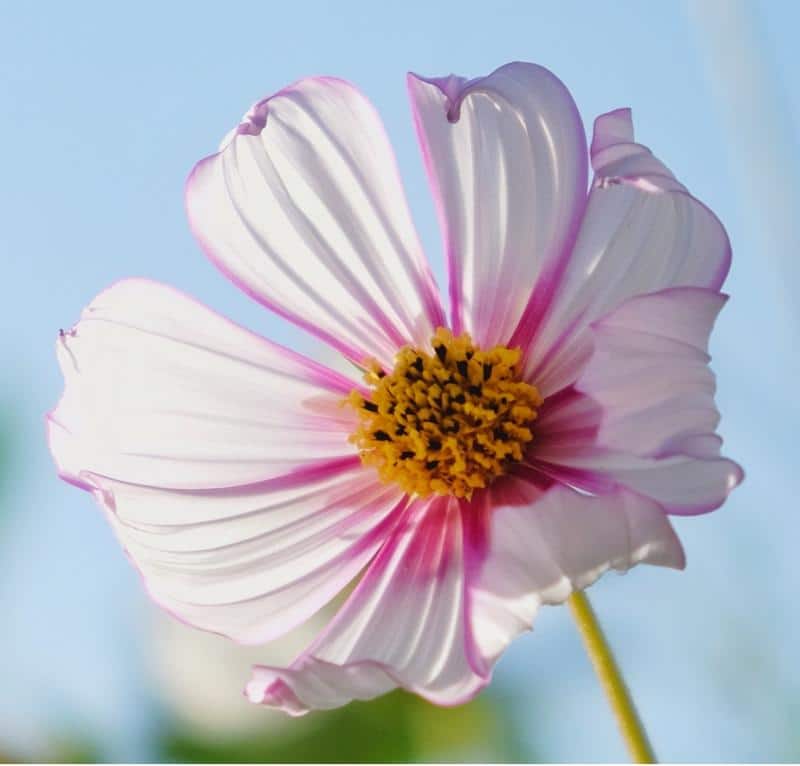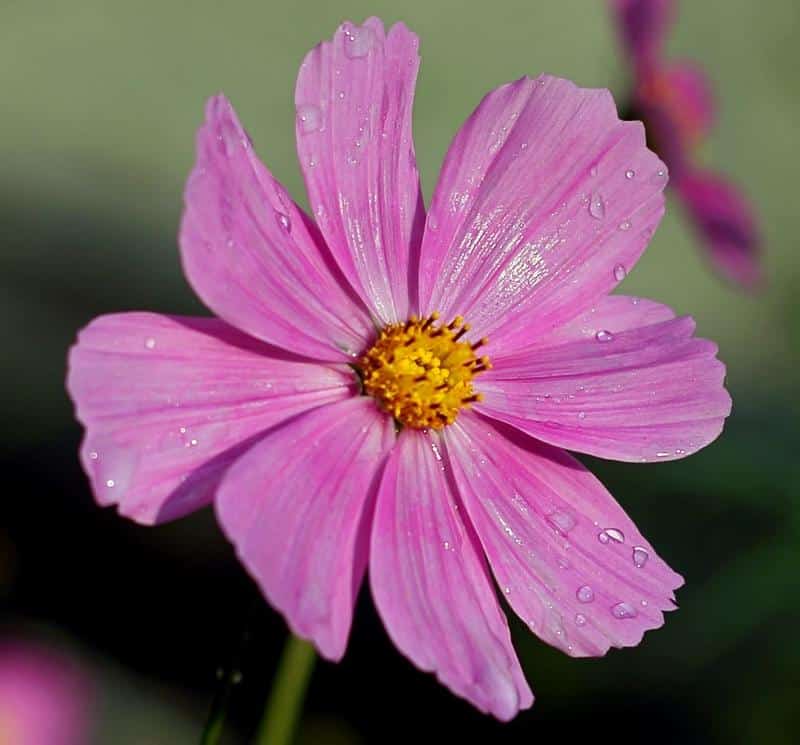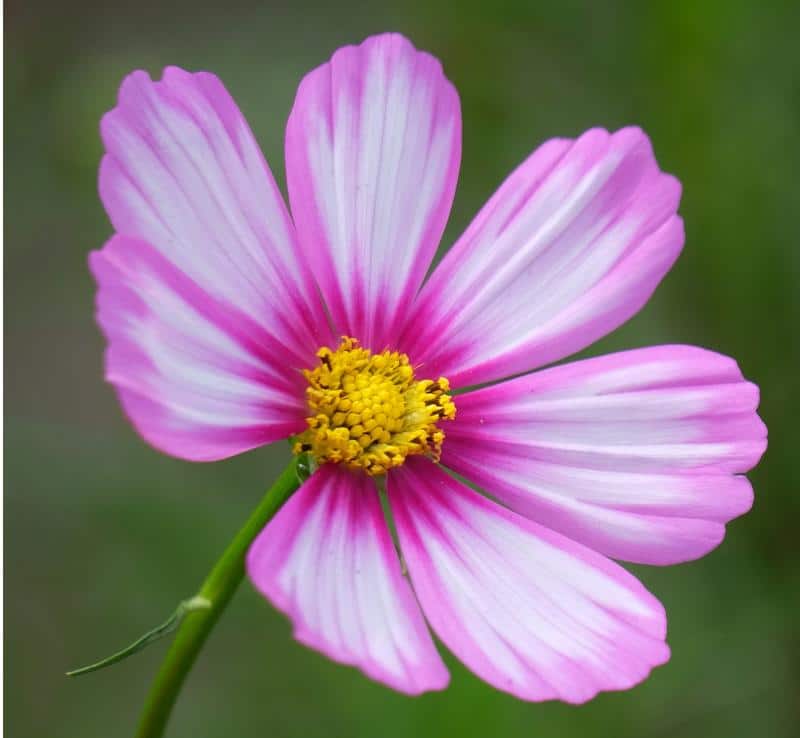Are Cosmos Poisonous to Dogs? Are Cosmos Toxic to Dogs?
Are Cosmos poisonous to dogs? Are Cosmos toxic to dogs? In this article, we’ll teach you everything you need to know about if Cosmos are safe for dogs including what to do if your dog ate a Cosmos flower already. We’ll then explain the two commands that will ensure your dog behaves around Cosmos and other potentially toxic plants.
Next, we’ll cover more things you should know about Cosmos and dogs, such as how to keep dogs away from Cosmos using barriers and other methods. Finally, we’ll instruct you on Cosmos flower care (annual or perennial, how tall, sun or shade, deer-resistant, zone, light and water requirements) and more to know when you have dogs. Keep reading!
Are Cosmos Poisonous to Dogs?

Cosmos are not poisonous to dogs. While they are generally safe, it’s always a good idea to keep an eye on your dog around plants and implement training to prevent unwanted nibbling. Eating too many can still cause an upset stomach, and also creates bad habits.
Are Cosmos Toxic to Dogs?
Cosmos are not toxic to dogs, according to the American Society for the Prevention of Cruelty to Animals (ASPCA). However, you should still discourage your dog from eating them, as consuming large quantities of any plant material may lead to gastrointestinal upset.
Training “Leave It” Command
One of the best ways to prevent your dog from eating Cosmos or other plants is to teach the “Leave It” command. This command tells your dog to stop what they’re doing and move away from an item. Here’s how you can train the “Leave It” command:
- Hold a treat in your closed hand and present it to your dog without letting them take it.
- When your dog stops trying to take the treat and pulls away, say “Leave It,” and give them a different treat from your other hand.
- Repeat this process, gradually increasing the challenge by placing the treat on the floor or closer to the dog.
- Always reward the dog for leaving the treat and responding to the command.
This command can be invaluable in keeping your dog away from plants and other objects you want them to avoid.
Training “Drop It” Command
The “Drop It” command is another important tool that instructs your dog to immediately drop whatever they have in their mouth. Training the “Drop It” command is similar to “Leave It” and can be done with the following steps:
- While playing a game of fetch, allow your dog to pick up a toy and then offer a treat in exchange for the toy.
- When your dog drops the toy, say “Drop It,” and reward them with the treat.
- Repeat the process, gradually phasing out the treat, and using only the command.
- Use the command in different situations to ensure the dog understands it in various contexts.
These commands will keep your dog safe around Cosmos and all other types of plants, but it’s important to remember that the underlying behavioral issues (curiosity, anxiety, boredom, etc.) that were causing all of this to begin with will still be present. And until you address those, any positive changes you see are only going to be temporary.
“Well, how do I make these changes last?”
By getting your dog to truly choose to follow your direction, that’s how. I tried many times to write out how you can do that before deciding it made more sense to just link you to the free video series that explains it better than I’d ever be able to.
The series is by a man named Dan who is one of the world’s leading dog obedience trainers. In it, he teaches you how to put an end to things like your dog getting too close to your Cosmos and all other misbehavior using his fast and easy-to-follow methods.
In the first video, Dan will reveal to you why the two most common methods of dog training only doom you to failure. You can watch the video now by clicking here. Follow the proven system he’ll show you in his series and you’ll never have to spend another second worrying about your dog eating Cosmos ever again!
Are Cosmos Safe for Dogs?

Cosmos are safe for dogs and are not considered toxic to our canine friends. While these vibrant and attractive flowers can be a beautiful addition to gardens, you may still have concerns about your dog interacting with them.
My Dog Ate a Cosmos Flower, What Do I Do?
If your dog ate a Cosmos flower, there’s no need to panic. Since Cosmos are not poisonous to dogs, ingestion is typically harmless. However, consuming any non-food plant material may lead to mild gastrointestinal discomfort in some dogs.
Monitor your pet for signs of discomfort, such as vomiting or diarrhea, and provide fresh water. If symptoms persist, consult with your veterinarian.
Dog Eating Cosmos: How to Prevent
While Cosmos flowers are not harmful to dogs, you should still discourage them from eating plants. Here are some methods to prevent your dog from nibbling on Cosmos or other garden flowers:
- Supervision: Always supervise your dog while they are in the garden or around plants.
- Training: Teaching commands like “Leave It” or “Drop It” can help you control your dog’s behavior around plants. Learn both now in the first section.
- Physical Barriers: Using fencing or other barriers can keep your dog away from specific areas where Cosmos are planted.
- Provide Alternatives: Offering dog-safe toys or treats can divert your dog’s attention from the plants.
What Attracts Dogs to Cosmos?
Dogs may be attracted to Cosmos and other plants due to a variety of factors. The bright colors and pleasant fragrance of Cosmos can catch a dog’s attention. Additionally, the texture of the petals or leaves might be appealing to chew on. Curiosity and natural foraging behavior may also lead a dog to explore plants.
Cosmos flowers are safe for dogs and do not pose a toxic risk. However, you should still monitor your dog around garden plants and implement strategies to prevent unwanted nibbling. Training commands (learn how in the first section), supervision, and providing alternatives can go a long way in ensuring both your garden’s beauty and your dog’s safety coexist harmoniously.
You should get this problem handled with your dog right away, as it will also keep them safe around other types of plants. You then won’t have to worry about things like is Cyclamen toxic to dogs, are Snapdragons toxic to dogs, are Nasturtiums poisonous to dogs, or is Angelonia toxic to dogs.
Cosmos and Dogs

Cosmos are not toxic to dogs and are considered safe if eaten. While these beautiful flowers pose no danger to our furry friends, you should still keep your pet away from them to preserve the garden and prevent unnecessary nibbling. In this guide, we will explore how to deter dogs from Cosmos flowers and other related considerations for your garden.
How to Keep Dogs Away From Cosmos
Keeping dogs away from Cosmos or other garden plants can be done using various methods that do not harm the pet or the plant. Here are some effective ways to deter dogs from approaching Cosmos:
- Install Fencing: A physical barrier like a fence or garden mesh can be a significant deterrent for dogs. This can protect the Cosmos without restricting the dog’s movement in the rest of the yard.
- Utilize Planters: Planting Cosmos in raised planters can make them less accessible to dogs, thus minimizing interaction.
- Train Commands: Teaching your dog commands like “Leave It” can prevent them from approaching or eating plants. Learn it now in the first section.
- Provide Dog-Friendly Zones: Designating specific areas in the garden where dogs are allowed to play can keep them away from the Cosmos.
Growing Cosmos in a Dog-Friendly Garden
Growing Cosmos in a garden with dogs doesn’t have to be a challenge. Selecting the right spot, using non-toxic fertilizers, and understanding both the plant’s and the dog’s needs can create harmony. Here’s how to maintain a dog-friendly garden with Cosmos:
- Choose Safe Locations: Plant Cosmos away from your dog’s favorite spots to reduce interference.
- Use Dog-Safe Fertilizers: Opt for organic or pet-friendly fertilizers to keep both the Cosmos and your dog healthy.
- Monitor Interaction: Keep an eye on how your dog interacts with the Cosmos and take action if needed.
Cosmos Varieties and Dogs
There are various Cosmos species that you can plant in a dog-friendly garden. Knowing which ones are most suitable for your specific situation can help you maintain a beautiful garden while ensuring your pet’s safety. Researching different Cosmos varieties and consulting with local experts can provide insights tailored to your garden’s conditions.
Cosmos and dogs can coexist in the same environment without any harmful effects. By implementing effective barriers, providing training (learn how in the first section), selecting appropriate Cosmos varieties, and understanding how to grow these beautiful flowers in a dog-friendly garden, you can enjoy the best of both worlds.
The beauty of Cosmos flowers and the joy of having a dog don’t have to be mutually exclusive, and with some careful planning, they can complement each other perfectly.
Cosmos Flower Care

Cosmos flowers are well-loved for their vibrant colors and easy-to-care nature. These flowers are suitable for both novice and experienced gardeners and can be grown in various climates. Proper care, including understanding their light, water, and soil requirements, ensures that Cosmos flourish and enhance the beauty of any garden.
Care For Cosmos Flower
Caring for Cosmos flowers is relatively simple. They require well-drained soil with a moderate amount of organic matter. Regular watering during dry spells and occasional deadheading will promote continuous blooming. Fertilizing is typically unnecessary, as Cosmos thrive in average soil.
Are Cosmos a Perennial?
Cosmos are usually grown as annuals, but some varieties can act as perennials in warmer climates (zones 9-11). They often self-seed, giving the appearance of a perennial by re-emerging in the same spot year after year.
How Tall Does Cosmos Grow?
Cosmos can grow to varying heights, depending on the variety. Most common Cosmos grow between 2 to 5 feet tall. Dwarf varieties are available, growing only 1 to 2 feet tall, suitable for containers or smaller garden spaces.
Cosmos: Deer-Resistant?
Yes, Cosmos are typically deer-resistant. Their aromatic foliage and taste are generally unappealing to deer, making them a suitable choice for gardens in areas where deer might be a concern.
Cosmos: Sun or Shade?
Cosmos thrive in full sun and require at least 6 to 8 hours of direct sunlight daily. While they can tolerate partial shade, too much shade may result in weak stems and fewer blooms.
Cosmos Zone
Cosmos can be grown in USDA hardiness zones 2-11. They are adaptable and can thrive in various climates, but their perennial or annual behavior may change depending on the specific zone.
Cosmos Light Requirements
Cosmos have a strong preference for full sun. Planting them in a spot that receives ample sunlight will ensure healthy growth and abundant flowering. The bright light enhances the vibrancy of their colors and helps maintain a robust plant structure.
Cosmos Water Requirements
Cosmos are relatively drought-tolerant but prefer consistent moisture, especially during the establishment phase. Watering deeply once a week is usually sufficient, and overwatering can lead to weak plants and potential disease issues.
In conclusion, Cosmos flowers are a versatile and attractive addition to any garden, bringing color and liveliness with minimal care requirements. Understanding the specific needs of Cosmos, such as their preference for sun, appropriate watering schedule, and recognizing their annual or perennial nature depending on the zone, allows gardeners to grow these stunning flowers successfully.
Whether planted in beds, borders, or containers, Cosmos can provide a delightful visual appeal to both human garden visitors and beneficial pollinators. Learn the two commands you should know to teach your dog to behave around these plants by going back to the first section now.
I’m sure you’re relieved to have all of your questions about Cosmos and dogs answered, so I’ll let you get started now. Good luck, and thanks for reading our article “Are Cosmos Poisonous to Dogs? Are Cosmos Toxic to Dogs?”





